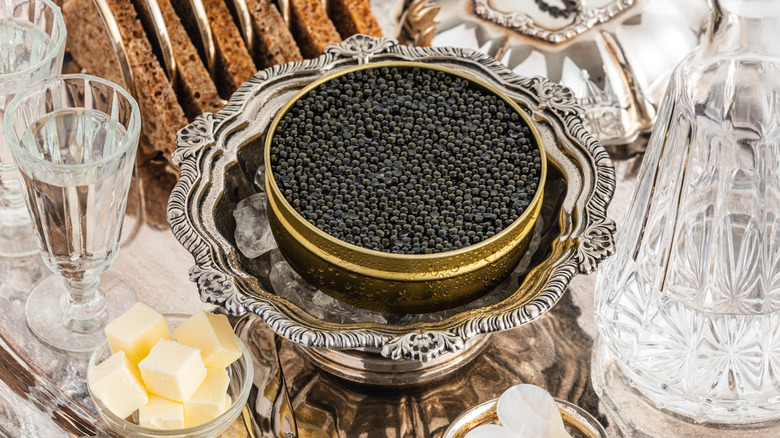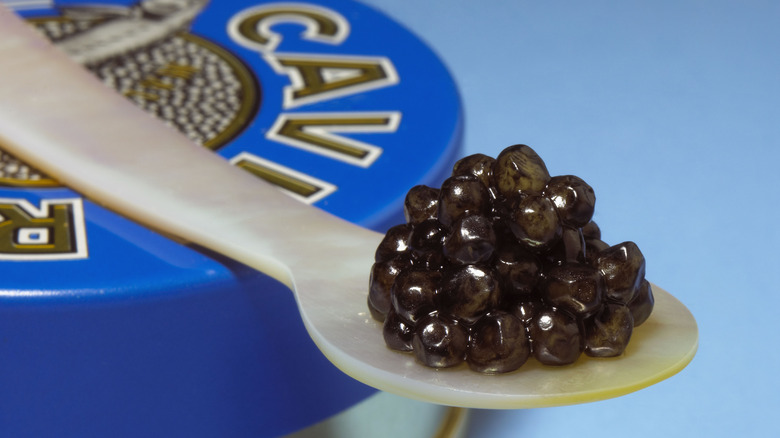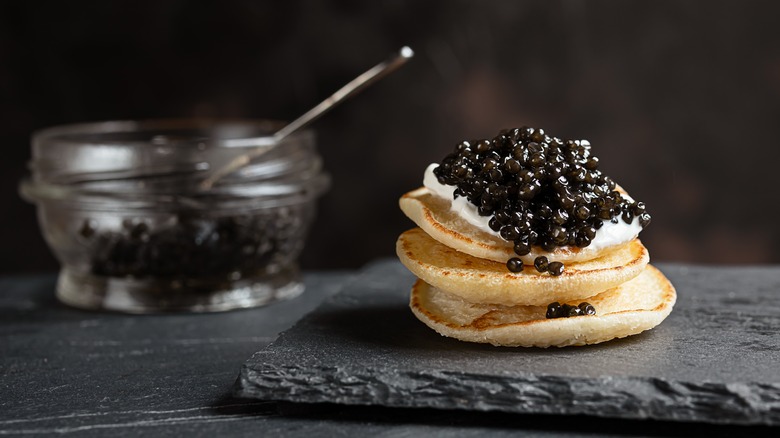What's The Difference Between Grade A And Grade B Caviar?
No other specialty food screams luxury quite like caviar. Lobster, oysters, and even truffles can't compare in and sophistication (and price). The opulent orbs have long been the delicacy of choice for the elite, most famously among Russian Czars. These treasured tins of salted fish roe are so coveted that they're sometimes even used as currency (per How Stuff Works). In fact, Czar Nicholas II was said to have collected taxes from fishermen in the form of caviar, per Sasanian Caviar.
The origins, laws, and availability of caviar have changed over the decades and centuries. But today, the appetite for caviar is as strong — and expensive — as ever, with the BBC reporting that the global caviar industry is worth $848 million. If you've decided that you're going to shell out the big bucks for some caviar for your next dinner party, it's probably a good idea to know a little more about what exactly you're getting yourself into.
Caviar prices can vary anywhere from $50 to $150 an ounce and higher depending on the quality, according to USA Today. There are multiple varieties and grades of caviar, and more than one country of origin, too. So before you go to the specialty foods store for a tin (or two, if you're feeling flush), arm yourself with a little basic information about the different categories of caviar, starting with the difference between grade A and grade B.
The caviar grading system
"Caviar" is an all-encompassing word, in a way, as the varieties can come from different parts of the world and contain different salt content, textures and flavors, and more. The first thing you need to know, though, is that true caviar only comes from sturgeon, per MasterClass. There are other types of fish roe that are also tasty, but they aren't technically caviar.
Many foods have categorizations that denote which is best, such as prime beef, and for caviar there is Grade A and Grade B, which are interchangeably referred to as Grade 1 and Grade 2 (per Caviar Stars). These classifications are determined when the roe is harvested and then evaluated by an expert for egg size, color, lucidity, uniformity, separation, firmness, fragrance, taste and maturity.
Grade A caviar is, as you may have guessed, the best — these eggs satisfy all of the criteria for high quality, including uniform, unbroken eggs with a firm but delicate texture and good fragrance. Grade B is no slouch, however. This second grade is still very good caviar, according to The Kitchn. The eggs are usually just less perfectly formed or misshaped — still delicious, it just can't command as high a price as Grade A. Caviar Stars adds that some producers also sometimes sort their products into subcategories, such as Grade 1+ for rarer quality products, or Grade 1A or 1B when they feel that the roe is not quite Grade A, but still higher quality than Grade B.
Types of caviar
Now that you know the grades, get to know some of the different types of caviar, which are named for the variety of sturgeon it comes from.
Beluga is considered the best (and thus the most expensive) caviar variety. It comes from Beluga sturgeon, which are native to the Black and Caspian Seas. Beluga are notoriously overfished, however, and Beluga caviar is banned in the United States. Kaluga caviar is similar in quality to Beluga but comes from freshwater sturgeon and is legal to buy in the US, as is Osetra, which is a little easier to find and has a more approachable flavor and texture that is great for first-timers. There is also a whole category of American caviar, which is produced by farmed, freshwater, and saltwater sturgeon. These homegrown roes can vary a lot in flavor and texture.
There are also plenty of delicious edible eggs from other fish varieties that aren't technically caviar but can be enjoyed much the same way as their sturgeon counterparts. They're also much less expensive than true caviar and include salmon, whitefish, paddlefish, spoonfish, flying fish, and more, per Wine Enthusiast. Whatever you choose, be sure to buy your caviar or roe from a reputable source. America's Test Kitchen reports that the industry suffers from a lot of fraud, poor practices, and lack of transparency. So be sure you're getting the real deal before you commit to spending the cash.


